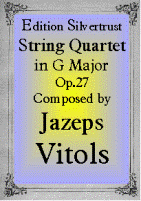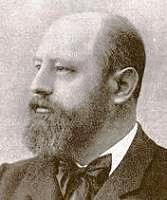Presents
Jazeps Vitols
 |
 |
Soundbites courtesy of Steve Jones |
String Quartet in G Major, Op.27
"Jazeps Vitols Op.27 String Quartet in
G Major appeared in 1899. The opening movement, Allegro commodo, to me sounds
like a kind of Idyll or Pastorale. The second somewhat somber theme is
particularly appealing. It is in the second movement, Adagio elegiaco that we
hear the use of Latvian folkmelody. This is also true of the third movement, an
Intermezzo, with its highly effective and charming use of pizzicato. The finale
begins with a slow, Andante introduction which quotes the opening theme from the
second movement. The main part of the movement, a nimble Allegro non troppo,
also appears based on Latvian folk melody. This quartet Presents
no technical
problems and is a pleasure to play. I especially recommend it to amateur quartet
players"---Wilhelm Altmann writing in his Handbook for String Quartet
Players.
Jazeps Vitols (1863-1948 also known as Josef or Joseph Wihtols in German) was born in the Latvian provincial capital of Valmiera, then part of the Russian Empire. He studied composition at the St. Petersburg Conservatory under Rimsky-Korsakov and subsequently taught there eventually becoming a professor or composition. Among his many students were Myaskovsky and Prokofiev. After the First World War, with the break up of the Russian Empire and the creation of the state of Latvia, he returned to its capital, Riga, and established the Latvian Conservatory and served as conductor of the Latvian National Opera later renamed after him. There his students included the important 20th century Latvian composers Janis Ivanovs and Adolfs Skulte. He was the first Latvian composer to be known internationally. He was held in high regard by both Korsakov and Glazunov who were especially impressed by the brilliance of his compositional uses of tonality.
Vitols' music falls into two periods. Up until 1910, he composed in the Russian National style espoused by Korsakov and Glazunov and his music sounds like that of the other composers of the Belaiev Circle such as Kopylov, Borondin, Sokolov and Gliere. However, Korsakov encouraged him to seek out Lativan folk music, which he did. After 1910, during the second period, he concentrated in putting native Lativan melodies into a classical formats such as opera, lieder and choral works. He was the first Latvian composer to do so and as a result, he is known as the Father of Latvian Music. His string quartet dates from the aforementioned first period.
Never reprinted, we are pleased to reintroduce a work that is sure to please both players and audiences alike.
Parts: $24.95